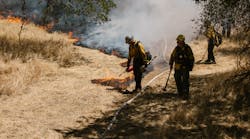Filtering Out Wildfire Smoke: How to Sustainably Manage Indoor Air Quality in a Climate Crisis
Each year, the climate crisis is having an increasingly significant impact on both the planet and people’s daily lives. Mainly, this impact manifests through a variety of environmental occurrences such as hurricanes, rising sea levels and temperatures, and wildfires. Warmer weather combined with drier conditions creates an environment in which fires can easily catch and rapidly spread. It’s not just the fire itself that can put lives and property in peril. Wildfire smoke is also a problem.
If you own or manage buildings in one of the areas whose regional vulnerability includes climate-related fires, this is a vital issue for consideration. After all, the content of wildfire smoke can make it particularly hazardous for people inside your buildings and alongside the properties themselves. Let’s take a look at the problem a little further and how you can sustainably manage indoor air quality through filtration.
Understand the Impact
Making changes to properties to filter out wildfire smoke in sustainable ways can take significant investment. Before committing to this, it’s natural to want to gain some insights into the imperatives for doing so.
Some of the impacts of wildfires include:
Health Risks
One of the first effects that you’ll find if there’s a wildfire nearby is some of the health issues that arise, especially those related to the respiratory system. The combination of gas and fine particles can induce coughing, asthma attacks and chest pain, among other symptoms.
Wildfires can also impact eye health. Smoke and air pollution can trigger symptoms of allergic conjunctivitis. You may experience swelling and puffiness around your eyes, thus affecting your quality of life. There can be further complications from conjunctivitis that result in corneal inflammation, ulcers and even scarring.
Property Condition Issues
Failing to effectively filter wildfire smoke from your properties can affect the condition of your building. Smoke has the potential to stain interior elements—from wallpaper to soft furnishings. If your properties also have electronic equipment inside, they can also be affected by the acidic properties and corrosive materials the smoke contains.
Financial Disruption
Any building owner or facilities manager likely recognizes that residents are important assets. Unfortunately, the frequent presence of potentially toxic wildfire smoke may mean that tenants are less willing to engage with your services. Canceled tenancies and even requests for lower rates could cause financial disruption to your business.
Consider Air Filtration Methods
Although you may not be able to control how and when wildfires occur, you can control how you address the wildfire smoke itself. Fighting indoor air pollution tends to be most successful when you focus on three key components of improving air quality. One of your most important steps, though, is to actively clean your indoor air using a purification or filtration system such as a high-efficiency particulate air (HEPA) filtration system.
They can purify the air of particles, smoke, pollen and other airborne contaminants. This tends to make them particularly suitable for wildfire scenarios as well as generally improving indoor air quality.
That said, many wildfires are the result of or exacerbated by climate change. It’s vital to approach your filtration choices with sustainability in mind so as not to further negatively impact the environment. Unfortunately, HEPA filtration systems require regular replacements to be effective, which isn’t always sustainable as new filters involve additional materials, manufacturing and transport. Not to mention that HEPA filters use energy on top of the energy needed for heating, ventilation and air-conditioning systems.
Wherever possible, ensure that the system you use either has reusable filters or they are made from recycled materials. It’s also important to check the efficiency rating of the system you invest in. The higher the percentage of efficiency, the less energy the system is likely to use. Higher-efficiency systems may be more expensive in the initial outlay, but this is environmentally responsible and you may save on overhead costs.
Adopt Tools that Support Air Quality
In addition to air filtration systems, it’s wise to adopt additional tools and methods that support air quality. Many of these tools may reduce your reliance on a single filtration system, and they can also boost the sustainability of the approach by minimizing the energy used.
Smart Monitoring and Controls
The rise of the digital landscape has made smart HVAC and filtration systems more accessible. Sensors can consistently monitor conditions on your property. This includes temperature, humidity, contamination and gas content, among other elements. The presence of excessive levels of either element can trigger the automatic activation of filter systems. Not only does this directly tackle the wildfire smoke issue, but it can also reduce energy consumption by not having filter systems running constantly.
Effective Sealants
One of the key steps for indoor air quality is to prevent pollution from entering the building in the first place. This not only maximizes protection but also minimizes the use of energy-consuming filters. Therefore, it’s important to regularly assess your properties for air leaks and arrange to seal these. This includes cracks in the structural materials, gaps around windows and insulation issues.
Conclusion
At the end of the day, the safety of your residents should be paramount. Considering the aforementioned steps will not only make your residents happier but will ensure everyone stays safe in your buildings.


